Marketing Report: Almarai's Strategy for UK Dairy Market Entry
VerifiedAdded on 2019/12/04
|19
|6252
|294
Report
AI Summary
This marketing report provides a comprehensive analysis of Almarai's potential entry into the UK dairy market. It begins with an introduction to Almarai, its mission, vision, and values, highlighting its position as a market leader in the dairy segment within Saudi Arabia and the GCC region. The report then delves into a PESTLE analysis of the UK market, examining political, economic, social, technological, legal, and ecological factors that could influence Almarai's operations. Following this, a Porter's Five Forces analysis assesses the competitive landscape of the UK dairy liquids market, considering the bargaining power of buyers and suppliers, the threat of substitutes and new entrants, and industry rivalry. The report also outlines Almarai's product offerings, market position, and competitors in the UK. Finally, a SWOT analysis evaluates Almarai's internal strengths and weaknesses, as well as external opportunities and threats, providing strategic recommendations for successful market entry.
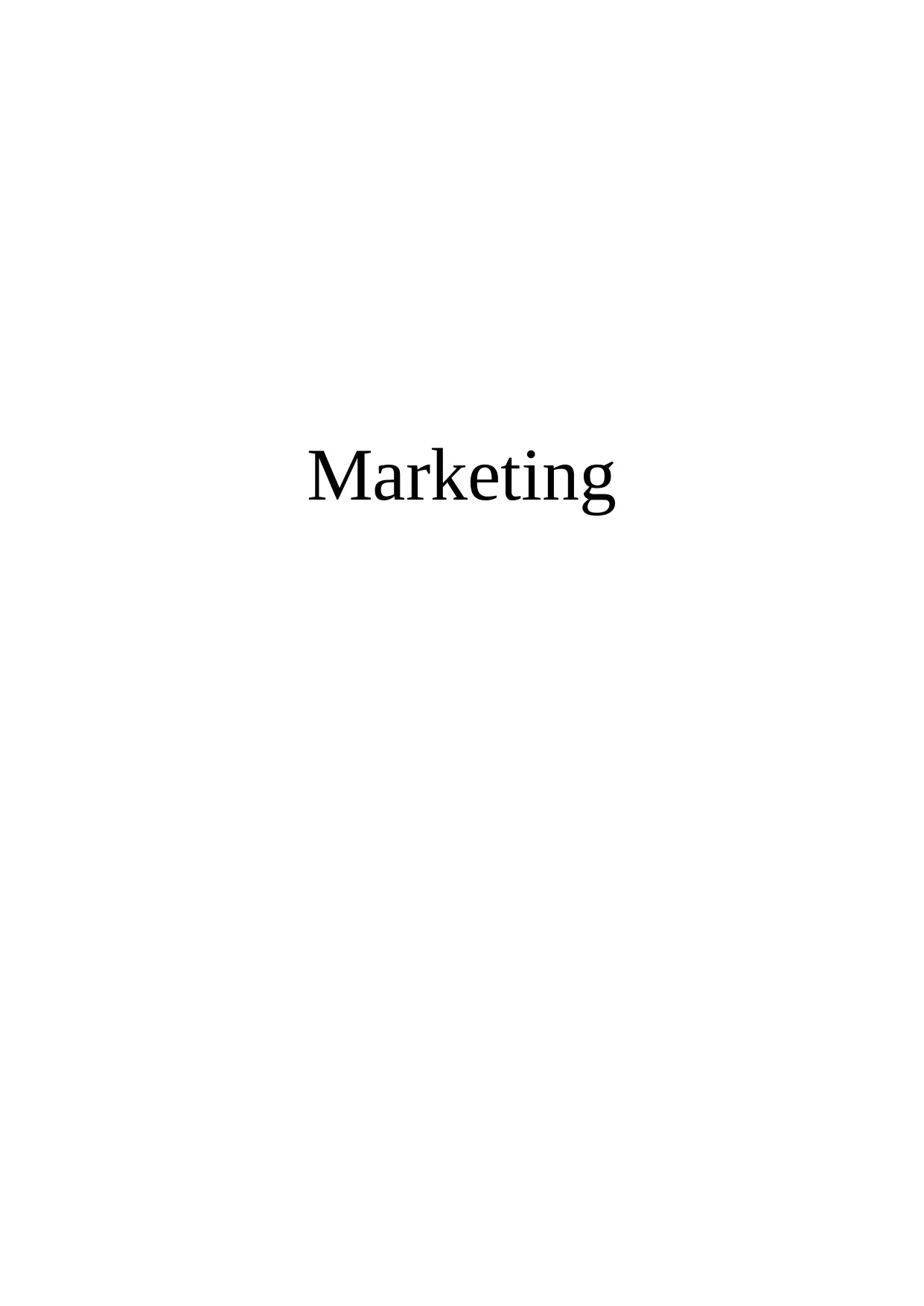
Marketing
Paraphrase This Document
Need a fresh take? Get an instant paraphrase of this document with our AI Paraphraser
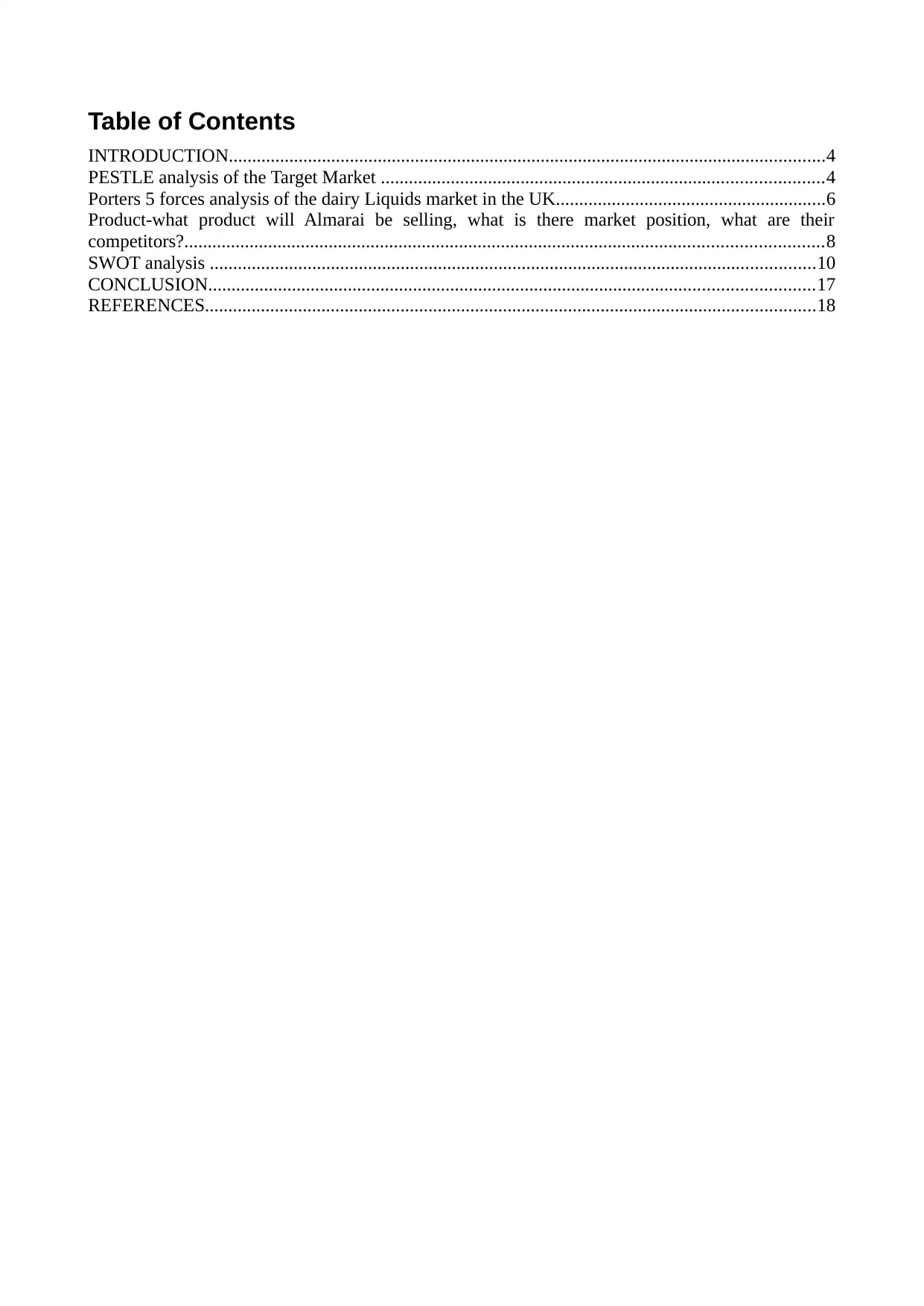
Table of Contents
INTRODUCTION................................................................................................................................4
PESTLE analysis of the Target Market ...............................................................................................4
Porters 5 forces analysis of the dairy Liquids market in the UK..........................................................6
Product-what product will Almarai be selling, what is there market position, what are their
competitors?.........................................................................................................................................8
SWOT analysis ..................................................................................................................................10
CONCLUSION..................................................................................................................................17
REFERENCES...................................................................................................................................18
INTRODUCTION................................................................................................................................4
PESTLE analysis of the Target Market ...............................................................................................4
Porters 5 forces analysis of the dairy Liquids market in the UK..........................................................6
Product-what product will Almarai be selling, what is there market position, what are their
competitors?.........................................................................................................................................8
SWOT analysis ..................................................................................................................................10
CONCLUSION..................................................................................................................................17
REFERENCES...................................................................................................................................18
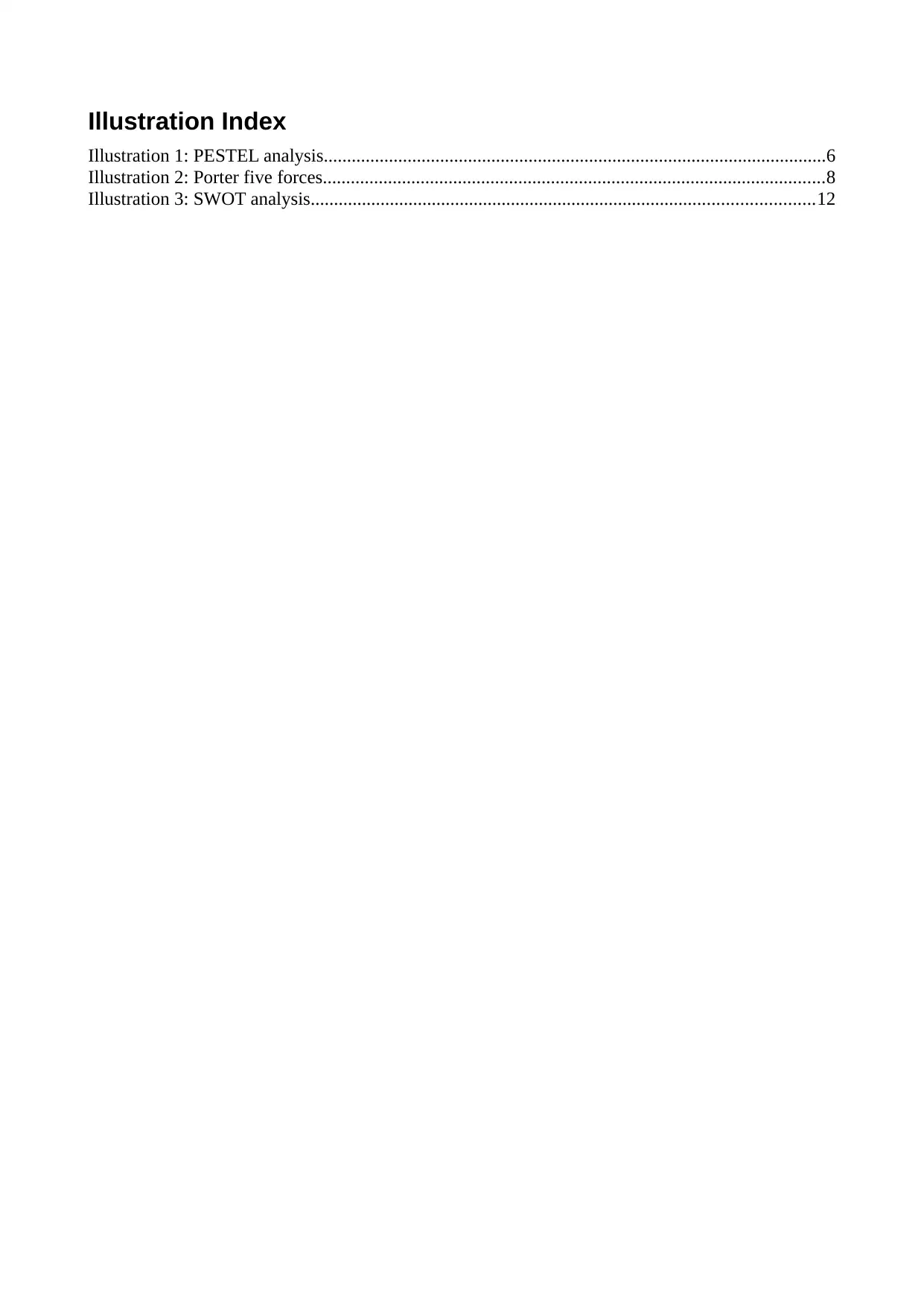
Illustration Index
Illustration 1: PESTEL analysis............................................................................................................6
Illustration 2: Porter five forces............................................................................................................8
Illustration 3: SWOT analysis............................................................................................................12
Illustration 1: PESTEL analysis............................................................................................................6
Illustration 2: Porter five forces............................................................................................................8
Illustration 3: SWOT analysis............................................................................................................12
⊘ This is a preview!⊘
Do you want full access?
Subscribe today to unlock all pages.

Trusted by 1+ million students worldwide
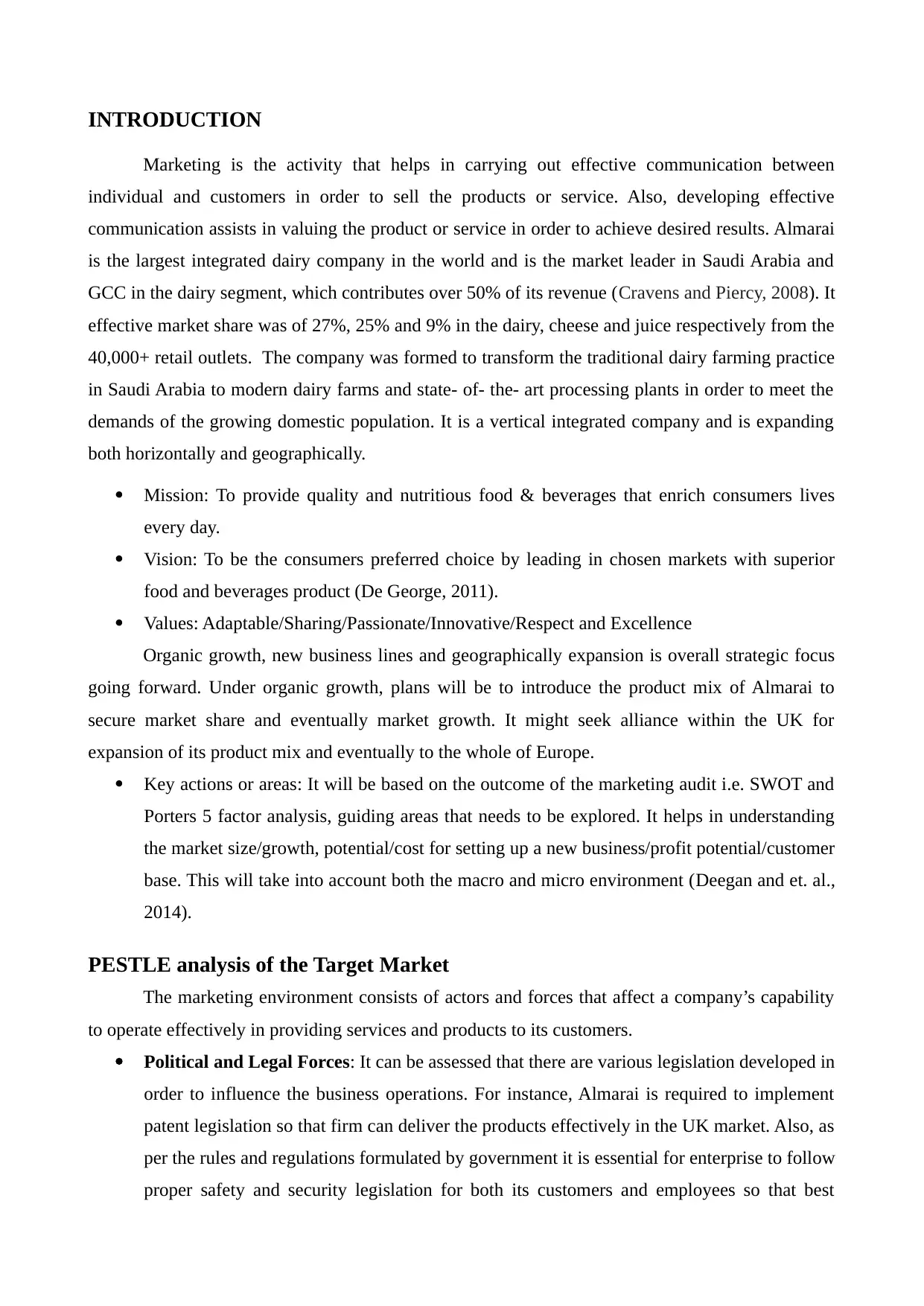
INTRODUCTION
Marketing is the activity that helps in carrying out effective communication between
individual and customers in order to sell the products or service. Also, developing effective
communication assists in valuing the product or service in order to achieve desired results. Almarai
is the largest integrated dairy company in the world and is the market leader in Saudi Arabia and
GCC in the dairy segment, which contributes over 50% of its revenue (Cravens and Piercy, 2008). It
effective market share was of 27%, 25% and 9% in the dairy, cheese and juice respectively from the
40,000+ retail outlets. The company was formed to transform the traditional dairy farming practice
in Saudi Arabia to modern dairy farms and state- of- the- art processing plants in order to meet the
demands of the growing domestic population. It is a vertical integrated company and is expanding
both horizontally and geographically.
Mission: To provide quality and nutritious food & beverages that enrich consumers lives
every day.
Vision: To be the consumers preferred choice by leading in chosen markets with superior
food and beverages product (De George, 2011).
Values: Adaptable/Sharing/Passionate/Innovative/Respect and Excellence
Organic growth, new business lines and geographically expansion is overall strategic focus
going forward. Under organic growth, plans will be to introduce the product mix of Almarai to
secure market share and eventually market growth. It might seek alliance within the UK for
expansion of its product mix and eventually to the whole of Europe.
Key actions or areas: It will be based on the outcome of the marketing audit i.e. SWOT and
Porters 5 factor analysis, guiding areas that needs to be explored. It helps in understanding
the market size/growth, potential/cost for setting up a new business/profit potential/customer
base. This will take into account both the macro and micro environment (Deegan and et. al.,
2014).
PESTLE analysis of the Target Market
The marketing environment consists of actors and forces that affect a company’s capability
to operate effectively in providing services and products to its customers.
Political and Legal Forces: It can be assessed that there are various legislation developed in
order to influence the business operations. For instance, Almarai is required to implement
patent legislation so that firm can deliver the products effectively in the UK market. Also, as
per the rules and regulations formulated by government it is essential for enterprise to follow
proper safety and security legislation for both its customers and employees so that best
Marketing is the activity that helps in carrying out effective communication between
individual and customers in order to sell the products or service. Also, developing effective
communication assists in valuing the product or service in order to achieve desired results. Almarai
is the largest integrated dairy company in the world and is the market leader in Saudi Arabia and
GCC in the dairy segment, which contributes over 50% of its revenue (Cravens and Piercy, 2008). It
effective market share was of 27%, 25% and 9% in the dairy, cheese and juice respectively from the
40,000+ retail outlets. The company was formed to transform the traditional dairy farming practice
in Saudi Arabia to modern dairy farms and state- of- the- art processing plants in order to meet the
demands of the growing domestic population. It is a vertical integrated company and is expanding
both horizontally and geographically.
Mission: To provide quality and nutritious food & beverages that enrich consumers lives
every day.
Vision: To be the consumers preferred choice by leading in chosen markets with superior
food and beverages product (De George, 2011).
Values: Adaptable/Sharing/Passionate/Innovative/Respect and Excellence
Organic growth, new business lines and geographically expansion is overall strategic focus
going forward. Under organic growth, plans will be to introduce the product mix of Almarai to
secure market share and eventually market growth. It might seek alliance within the UK for
expansion of its product mix and eventually to the whole of Europe.
Key actions or areas: It will be based on the outcome of the marketing audit i.e. SWOT and
Porters 5 factor analysis, guiding areas that needs to be explored. It helps in understanding
the market size/growth, potential/cost for setting up a new business/profit potential/customer
base. This will take into account both the macro and micro environment (Deegan and et. al.,
2014).
PESTLE analysis of the Target Market
The marketing environment consists of actors and forces that affect a company’s capability
to operate effectively in providing services and products to its customers.
Political and Legal Forces: It can be assessed that there are various legislation developed in
order to influence the business operations. For instance, Almarai is required to implement
patent legislation so that firm can deliver the products effectively in the UK market. Also, as
per the rules and regulations formulated by government it is essential for enterprise to follow
proper safety and security legislation for both its customers and employees so that best
Paraphrase This Document
Need a fresh take? Get an instant paraphrase of this document with our AI Paraphraser
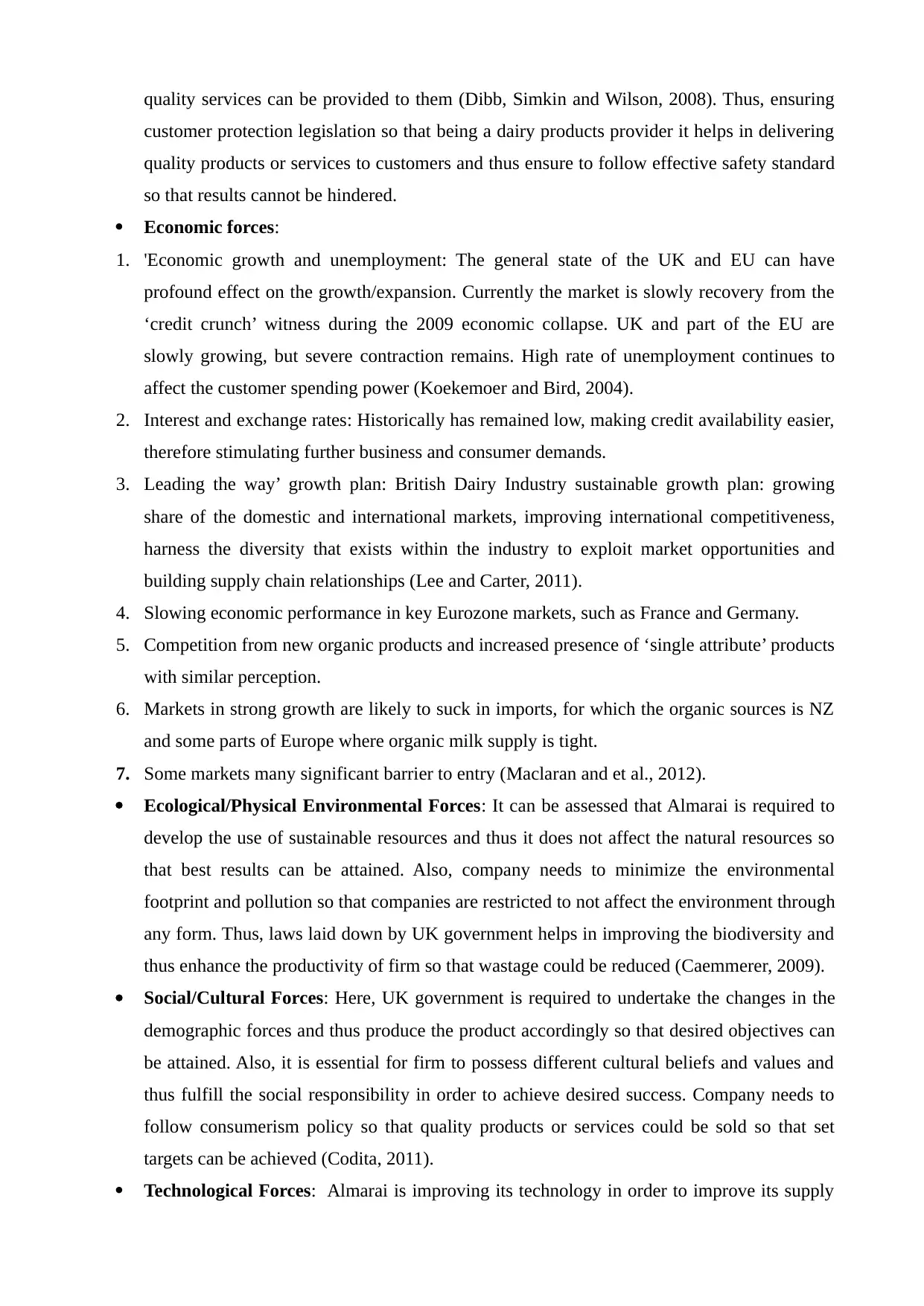
quality services can be provided to them (Dibb, Simkin and Wilson, 2008). Thus, ensuring
customer protection legislation so that being a dairy products provider it helps in delivering
quality products or services to customers and thus ensure to follow effective safety standard
so that results cannot be hindered.
Economic forces:
1. 'Economic growth and unemployment: The general state of the UK and EU can have
profound effect on the growth/expansion. Currently the market is slowly recovery from the
‘credit crunch’ witness during the 2009 economic collapse. UK and part of the EU are
slowly growing, but severe contraction remains. High rate of unemployment continues to
affect the customer spending power (Koekemoer and Bird, 2004).
2. Interest and exchange rates: Historically has remained low, making credit availability easier,
therefore stimulating further business and consumer demands.
3. Leading the way’ growth plan: British Dairy Industry sustainable growth plan: growing
share of the domestic and international markets, improving international competitiveness,
harness the diversity that exists within the industry to exploit market opportunities and
building supply chain relationships (Lee and Carter, 2011).
4. Slowing economic performance in key Eurozone markets, such as France and Germany.
5. Competition from new organic products and increased presence of ‘single attribute’ products
with similar perception.
6. Markets in strong growth are likely to suck in imports, for which the organic sources is NZ
and some parts of Europe where organic milk supply is tight.
7. Some markets many significant barrier to entry (Maclaran and et al., 2012).
Ecological/Physical Environmental Forces: It can be assessed that Almarai is required to
develop the use of sustainable resources and thus it does not affect the natural resources so
that best results can be attained. Also, company needs to minimize the environmental
footprint and pollution so that companies are restricted to not affect the environment through
any form. Thus, laws laid down by UK government helps in improving the biodiversity and
thus enhance the productivity of firm so that wastage could be reduced (Caemmerer, 2009).
Social/Cultural Forces: Here, UK government is required to undertake the changes in the
demographic forces and thus produce the product accordingly so that desired objectives can
be attained. Also, it is essential for firm to possess different cultural beliefs and values and
thus fulfill the social responsibility in order to achieve desired success. Company needs to
follow consumerism policy so that quality products or services could be sold so that set
targets can be achieved (Codita, 2011).
Technological Forces: Almarai is improving its technology in order to improve its supply
customer protection legislation so that being a dairy products provider it helps in delivering
quality products or services to customers and thus ensure to follow effective safety standard
so that results cannot be hindered.
Economic forces:
1. 'Economic growth and unemployment: The general state of the UK and EU can have
profound effect on the growth/expansion. Currently the market is slowly recovery from the
‘credit crunch’ witness during the 2009 economic collapse. UK and part of the EU are
slowly growing, but severe contraction remains. High rate of unemployment continues to
affect the customer spending power (Koekemoer and Bird, 2004).
2. Interest and exchange rates: Historically has remained low, making credit availability easier,
therefore stimulating further business and consumer demands.
3. Leading the way’ growth plan: British Dairy Industry sustainable growth plan: growing
share of the domestic and international markets, improving international competitiveness,
harness the diversity that exists within the industry to exploit market opportunities and
building supply chain relationships (Lee and Carter, 2011).
4. Slowing economic performance in key Eurozone markets, such as France and Germany.
5. Competition from new organic products and increased presence of ‘single attribute’ products
with similar perception.
6. Markets in strong growth are likely to suck in imports, for which the organic sources is NZ
and some parts of Europe where organic milk supply is tight.
7. Some markets many significant barrier to entry (Maclaran and et al., 2012).
Ecological/Physical Environmental Forces: It can be assessed that Almarai is required to
develop the use of sustainable resources and thus it does not affect the natural resources so
that best results can be attained. Also, company needs to minimize the environmental
footprint and pollution so that companies are restricted to not affect the environment through
any form. Thus, laws laid down by UK government helps in improving the biodiversity and
thus enhance the productivity of firm so that wastage could be reduced (Caemmerer, 2009).
Social/Cultural Forces: Here, UK government is required to undertake the changes in the
demographic forces and thus produce the product accordingly so that desired objectives can
be attained. Also, it is essential for firm to possess different cultural beliefs and values and
thus fulfill the social responsibility in order to achieve desired success. Company needs to
follow consumerism policy so that quality products or services could be sold so that set
targets can be achieved (Codita, 2011).
Technological Forces: Almarai is improving its technology in order to improve its supply
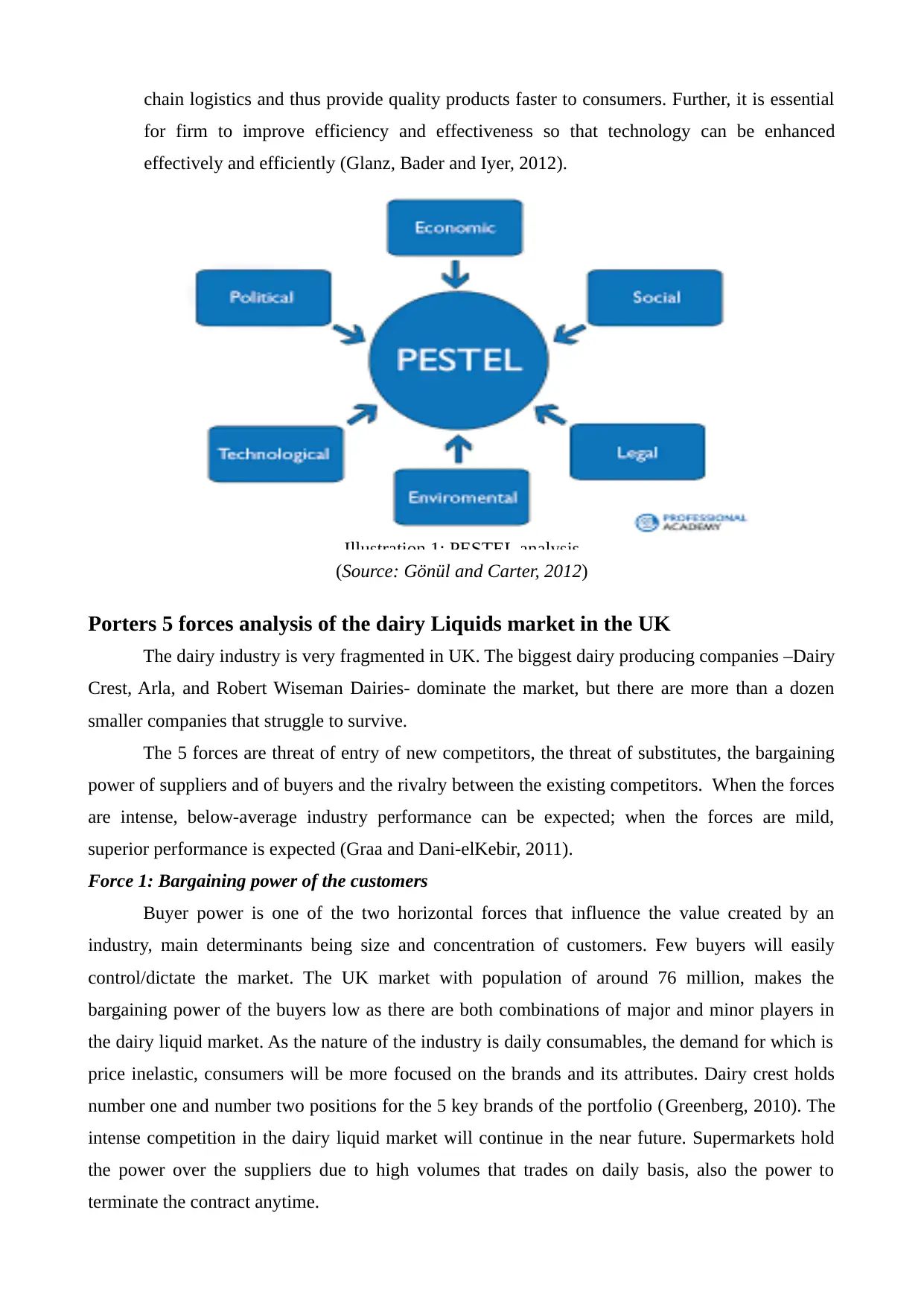
chain logistics and thus provide quality products faster to consumers. Further, it is essential
for firm to improve efficiency and effectiveness so that technology can be enhanced
effectively and efficiently (Glanz, Bader and Iyer, 2012).
Illustration 1: PESTEL analysis
(Source: Gönül and Carter, 2012)
Porters 5 forces analysis of the dairy Liquids market in the UK
The dairy industry is very fragmented in UK. The biggest dairy producing companies –Dairy
Crest, Arla, and Robert Wiseman Dairies- dominate the market, but there are more than a dozen
smaller companies that struggle to survive.
The 5 forces are threat of entry of new competitors, the threat of substitutes, the bargaining
power of suppliers and of buyers and the rivalry between the existing competitors. When the forces
are intense, below-average industry performance can be expected; when the forces are mild,
superior performance is expected (Graa and Dani-elKebir, 2011).
Force 1: Bargaining power of the customers
Buyer power is one of the two horizontal forces that influence the value created by an
industry, main determinants being size and concentration of customers. Few buyers will easily
control/dictate the market. The UK market with population of around 76 million, makes the
bargaining power of the buyers low as there are both combinations of major and minor players in
the dairy liquid market. As the nature of the industry is daily consumables, the demand for which is
price inelastic, consumers will be more focused on the brands and its attributes. Dairy crest holds
number one and number two positions for the 5 key brands of the portfolio (Greenberg, 2010). The
intense competition in the dairy liquid market will continue in the near future. Supermarkets hold
the power over the suppliers due to high volumes that trades on daily basis, also the power to
terminate the contract anytime.
for firm to improve efficiency and effectiveness so that technology can be enhanced
effectively and efficiently (Glanz, Bader and Iyer, 2012).
Illustration 1: PESTEL analysis
(Source: Gönül and Carter, 2012)
Porters 5 forces analysis of the dairy Liquids market in the UK
The dairy industry is very fragmented in UK. The biggest dairy producing companies –Dairy
Crest, Arla, and Robert Wiseman Dairies- dominate the market, but there are more than a dozen
smaller companies that struggle to survive.
The 5 forces are threat of entry of new competitors, the threat of substitutes, the bargaining
power of suppliers and of buyers and the rivalry between the existing competitors. When the forces
are intense, below-average industry performance can be expected; when the forces are mild,
superior performance is expected (Graa and Dani-elKebir, 2011).
Force 1: Bargaining power of the customers
Buyer power is one of the two horizontal forces that influence the value created by an
industry, main determinants being size and concentration of customers. Few buyers will easily
control/dictate the market. The UK market with population of around 76 million, makes the
bargaining power of the buyers low as there are both combinations of major and minor players in
the dairy liquid market. As the nature of the industry is daily consumables, the demand for which is
price inelastic, consumers will be more focused on the brands and its attributes. Dairy crest holds
number one and number two positions for the 5 key brands of the portfolio (Greenberg, 2010). The
intense competition in the dairy liquid market will continue in the near future. Supermarkets hold
the power over the suppliers due to high volumes that trades on daily basis, also the power to
terminate the contract anytime.
⊘ This is a preview!⊘
Do you want full access?
Subscribe today to unlock all pages.

Trusted by 1+ million students worldwide
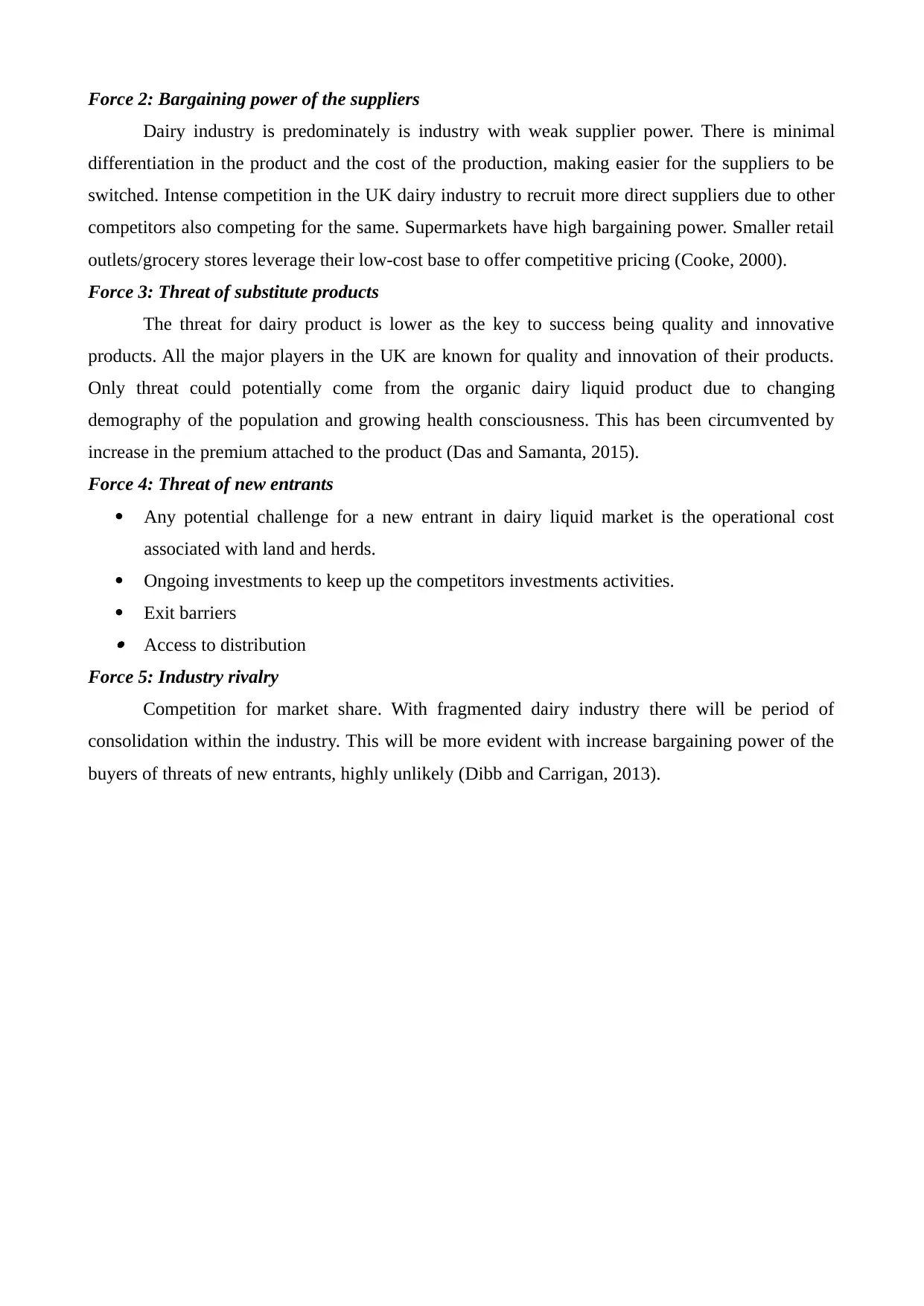
Force 2: Bargaining power of the suppliers
Dairy industry is predominately is industry with weak supplier power. There is minimal
differentiation in the product and the cost of the production, making easier for the suppliers to be
switched. Intense competition in the UK dairy industry to recruit more direct suppliers due to other
competitors also competing for the same. Supermarkets have high bargaining power. Smaller retail
outlets/grocery stores leverage their low-cost base to offer competitive pricing (Cooke, 2000).
Force 3: Threat of substitute products
The threat for dairy product is lower as the key to success being quality and innovative
products. All the major players in the UK are known for quality and innovation of their products.
Only threat could potentially come from the organic dairy liquid product due to changing
demography of the population and growing health consciousness. This has been circumvented by
increase in the premium attached to the product (Das and Samanta, 2015).
Force 4: Threat of new entrants
Any potential challenge for a new entrant in dairy liquid market is the operational cost
associated with land and herds.
Ongoing investments to keep up the competitors investments activities.
Exit barriers Access to distribution
Force 5: Industry rivalry
Competition for market share. With fragmented dairy industry there will be period of
consolidation within the industry. This will be more evident with increase bargaining power of the
buyers of threats of new entrants, highly unlikely (Dibb and Carrigan, 2013).
Dairy industry is predominately is industry with weak supplier power. There is minimal
differentiation in the product and the cost of the production, making easier for the suppliers to be
switched. Intense competition in the UK dairy industry to recruit more direct suppliers due to other
competitors also competing for the same. Supermarkets have high bargaining power. Smaller retail
outlets/grocery stores leverage their low-cost base to offer competitive pricing (Cooke, 2000).
Force 3: Threat of substitute products
The threat for dairy product is lower as the key to success being quality and innovative
products. All the major players in the UK are known for quality and innovation of their products.
Only threat could potentially come from the organic dairy liquid product due to changing
demography of the population and growing health consciousness. This has been circumvented by
increase in the premium attached to the product (Das and Samanta, 2015).
Force 4: Threat of new entrants
Any potential challenge for a new entrant in dairy liquid market is the operational cost
associated with land and herds.
Ongoing investments to keep up the competitors investments activities.
Exit barriers Access to distribution
Force 5: Industry rivalry
Competition for market share. With fragmented dairy industry there will be period of
consolidation within the industry. This will be more evident with increase bargaining power of the
buyers of threats of new entrants, highly unlikely (Dibb and Carrigan, 2013).
Paraphrase This Document
Need a fresh take? Get an instant paraphrase of this document with our AI Paraphraser
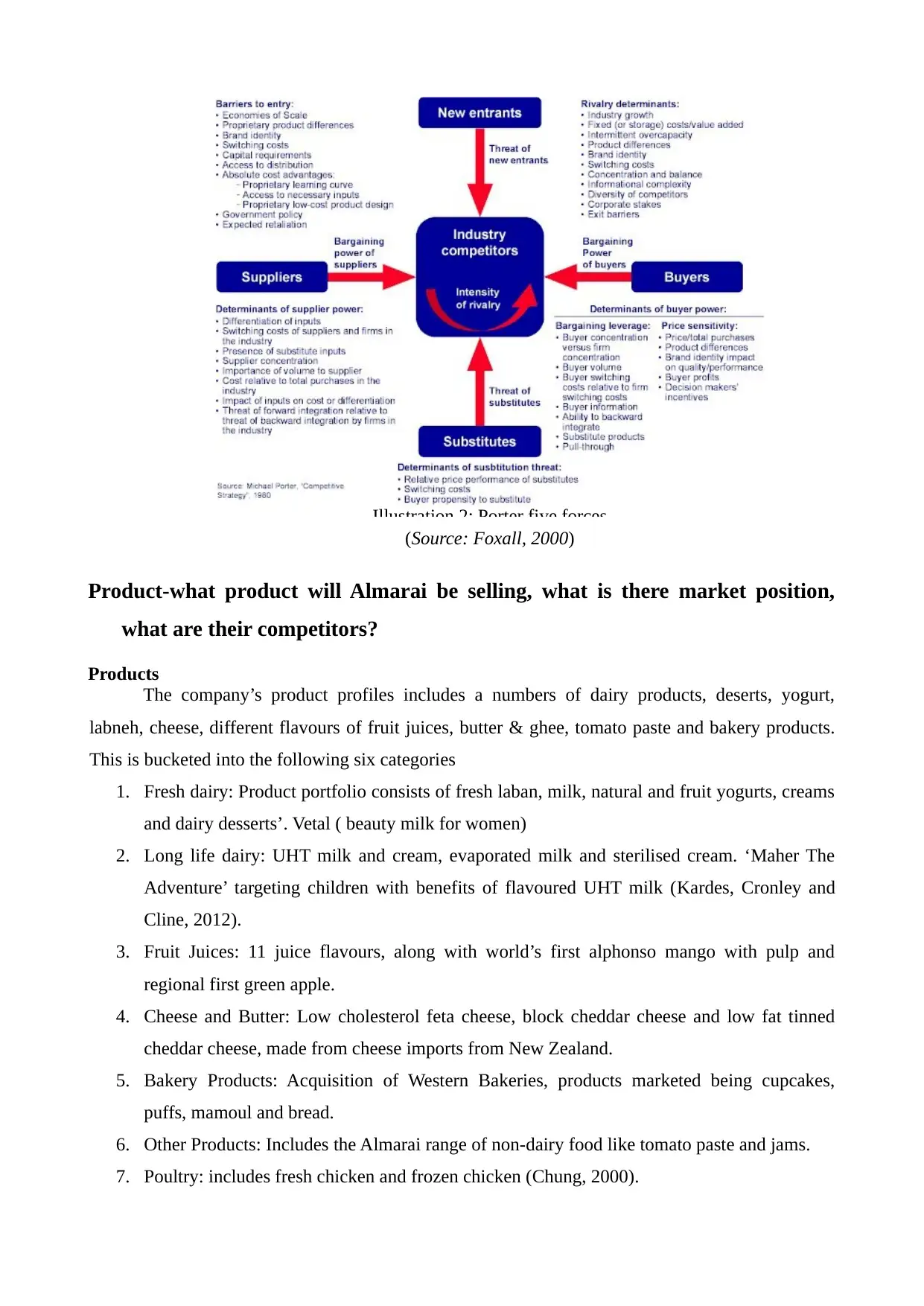
Illustration 2: Porter five forces
(Source: Foxall, 2000)
Product-what product will Almarai be selling, what is there market position,
what are their competitors?
Products
The company’s product profiles includes a numbers of dairy products, deserts, yogurt,
labneh, cheese, different flavours of fruit juices, butter & ghee, tomato paste and bakery products.
This is bucketed into the following six categories
1. Fresh dairy: Product portfolio consists of fresh laban, milk, natural and fruit yogurts, creams
and dairy desserts’. Vetal ( beauty milk for women)
2. Long life dairy: UHT milk and cream, evaporated milk and sterilised cream. ‘Maher The
Adventure’ targeting children with benefits of flavoured UHT milk (Kardes, Cronley and
Cline, 2012).
3. Fruit Juices: 11 juice flavours, along with world’s first alphonso mango with pulp and
regional first green apple.
4. Cheese and Butter: Low cholesterol feta cheese, block cheddar cheese and low fat tinned
cheddar cheese, made from cheese imports from New Zealand.
5. Bakery Products: Acquisition of Western Bakeries, products marketed being cupcakes,
puffs, mamoul and bread.
6. Other Products: Includes the Almarai range of non-dairy food like tomato paste and jams.
7. Poultry: includes fresh chicken and frozen chicken (Chung, 2000).
(Source: Foxall, 2000)
Product-what product will Almarai be selling, what is there market position,
what are their competitors?
Products
The company’s product profiles includes a numbers of dairy products, deserts, yogurt,
labneh, cheese, different flavours of fruit juices, butter & ghee, tomato paste and bakery products.
This is bucketed into the following six categories
1. Fresh dairy: Product portfolio consists of fresh laban, milk, natural and fruit yogurts, creams
and dairy desserts’. Vetal ( beauty milk for women)
2. Long life dairy: UHT milk and cream, evaporated milk and sterilised cream. ‘Maher The
Adventure’ targeting children with benefits of flavoured UHT milk (Kardes, Cronley and
Cline, 2012).
3. Fruit Juices: 11 juice flavours, along with world’s first alphonso mango with pulp and
regional first green apple.
4. Cheese and Butter: Low cholesterol feta cheese, block cheddar cheese and low fat tinned
cheddar cheese, made from cheese imports from New Zealand.
5. Bakery Products: Acquisition of Western Bakeries, products marketed being cupcakes,
puffs, mamoul and bread.
6. Other Products: Includes the Almarai range of non-dairy food like tomato paste and jams.
7. Poultry: includes fresh chicken and frozen chicken (Chung, 2000).
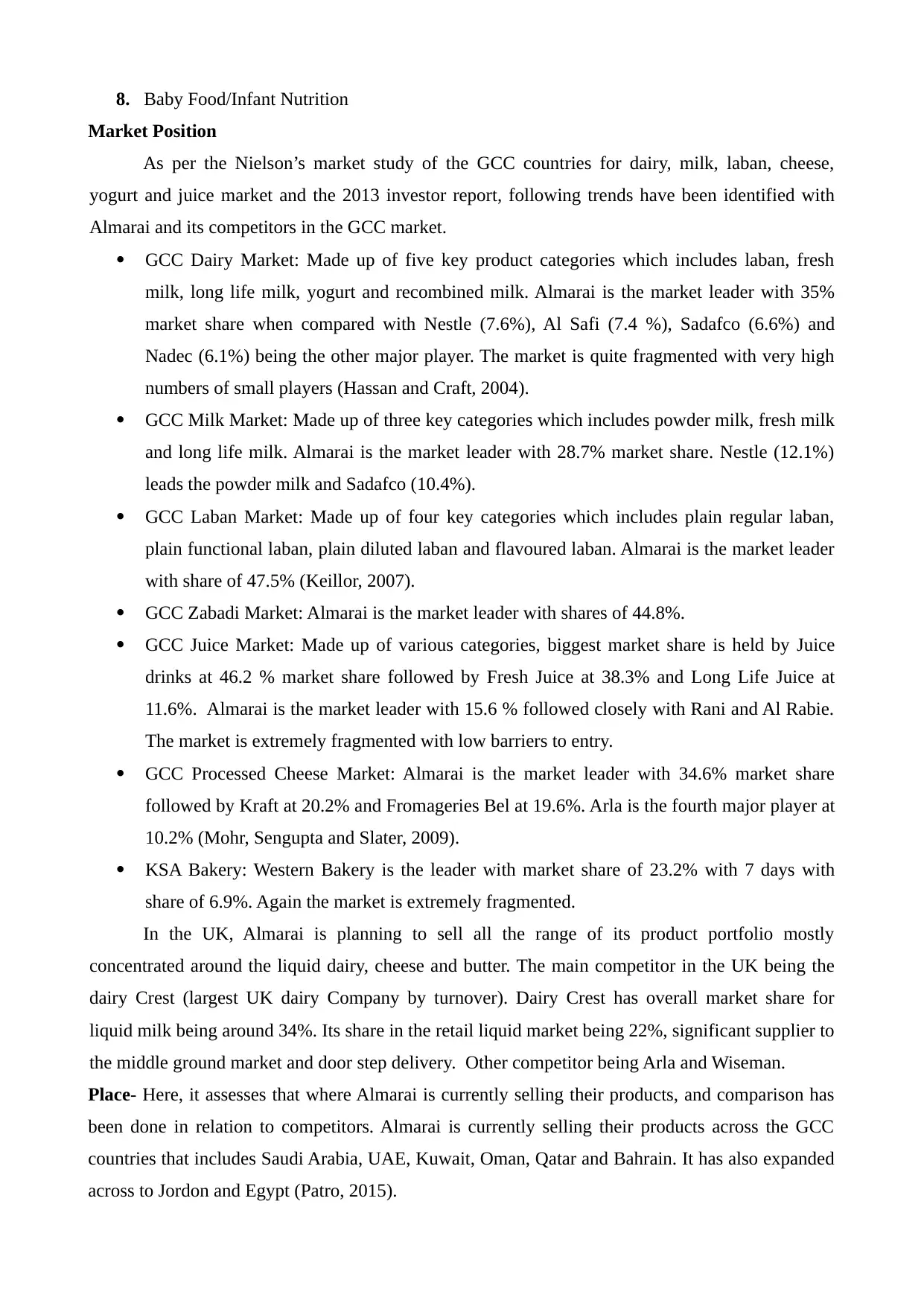
8. Baby Food/Infant Nutrition
Market Position
As per the Nielson’s market study of the GCC countries for dairy, milk, laban, cheese,
yogurt and juice market and the 2013 investor report, following trends have been identified with
Almarai and its competitors in the GCC market.
GCC Dairy Market: Made up of five key product categories which includes laban, fresh
milk, long life milk, yogurt and recombined milk. Almarai is the market leader with 35%
market share when compared with Nestle (7.6%), Al Safi (7.4 %), Sadafco (6.6%) and
Nadec (6.1%) being the other major player. The market is quite fragmented with very high
numbers of small players (Hassan and Craft, 2004).
GCC Milk Market: Made up of three key categories which includes powder milk, fresh milk
and long life milk. Almarai is the market leader with 28.7% market share. Nestle (12.1%)
leads the powder milk and Sadafco (10.4%).
GCC Laban Market: Made up of four key categories which includes plain regular laban,
plain functional laban, plain diluted laban and flavoured laban. Almarai is the market leader
with share of 47.5% (Keillor, 2007).
GCC Zabadi Market: Almarai is the market leader with shares of 44.8%.
GCC Juice Market: Made up of various categories, biggest market share is held by Juice
drinks at 46.2 % market share followed by Fresh Juice at 38.3% and Long Life Juice at
11.6%. Almarai is the market leader with 15.6 % followed closely with Rani and Al Rabie.
The market is extremely fragmented with low barriers to entry.
GCC Processed Cheese Market: Almarai is the market leader with 34.6% market share
followed by Kraft at 20.2% and Fromageries Bel at 19.6%. Arla is the fourth major player at
10.2% (Mohr, Sengupta and Slater, 2009).
KSA Bakery: Western Bakery is the leader with market share of 23.2% with 7 days with
share of 6.9%. Again the market is extremely fragmented.
In the UK, Almarai is planning to sell all the range of its product portfolio mostly
concentrated around the liquid dairy, cheese and butter. The main competitor in the UK being the
dairy Crest (largest UK dairy Company by turnover). Dairy Crest has overall market share for
liquid milk being around 34%. Its share in the retail liquid market being 22%, significant supplier to
the middle ground market and door step delivery. Other competitor being Arla and Wiseman.
Place- Here, it assesses that where Almarai is currently selling their products, and comparison has
been done in relation to competitors. Almarai is currently selling their products across the GCC
countries that includes Saudi Arabia, UAE, Kuwait, Oman, Qatar and Bahrain. It has also expanded
across to Jordon and Egypt (Patro, 2015).
Market Position
As per the Nielson’s market study of the GCC countries for dairy, milk, laban, cheese,
yogurt and juice market and the 2013 investor report, following trends have been identified with
Almarai and its competitors in the GCC market.
GCC Dairy Market: Made up of five key product categories which includes laban, fresh
milk, long life milk, yogurt and recombined milk. Almarai is the market leader with 35%
market share when compared with Nestle (7.6%), Al Safi (7.4 %), Sadafco (6.6%) and
Nadec (6.1%) being the other major player. The market is quite fragmented with very high
numbers of small players (Hassan and Craft, 2004).
GCC Milk Market: Made up of three key categories which includes powder milk, fresh milk
and long life milk. Almarai is the market leader with 28.7% market share. Nestle (12.1%)
leads the powder milk and Sadafco (10.4%).
GCC Laban Market: Made up of four key categories which includes plain regular laban,
plain functional laban, plain diluted laban and flavoured laban. Almarai is the market leader
with share of 47.5% (Keillor, 2007).
GCC Zabadi Market: Almarai is the market leader with shares of 44.8%.
GCC Juice Market: Made up of various categories, biggest market share is held by Juice
drinks at 46.2 % market share followed by Fresh Juice at 38.3% and Long Life Juice at
11.6%. Almarai is the market leader with 15.6 % followed closely with Rani and Al Rabie.
The market is extremely fragmented with low barriers to entry.
GCC Processed Cheese Market: Almarai is the market leader with 34.6% market share
followed by Kraft at 20.2% and Fromageries Bel at 19.6%. Arla is the fourth major player at
10.2% (Mohr, Sengupta and Slater, 2009).
KSA Bakery: Western Bakery is the leader with market share of 23.2% with 7 days with
share of 6.9%. Again the market is extremely fragmented.
In the UK, Almarai is planning to sell all the range of its product portfolio mostly
concentrated around the liquid dairy, cheese and butter. The main competitor in the UK being the
dairy Crest (largest UK dairy Company by turnover). Dairy Crest has overall market share for
liquid milk being around 34%. Its share in the retail liquid market being 22%, significant supplier to
the middle ground market and door step delivery. Other competitor being Arla and Wiseman.
Place- Here, it assesses that where Almarai is currently selling their products, and comparison has
been done in relation to competitors. Almarai is currently selling their products across the GCC
countries that includes Saudi Arabia, UAE, Kuwait, Oman, Qatar and Bahrain. It has also expanded
across to Jordon and Egypt (Patro, 2015).
⊘ This is a preview!⊘
Do you want full access?
Subscribe today to unlock all pages.

Trusted by 1+ million students worldwide
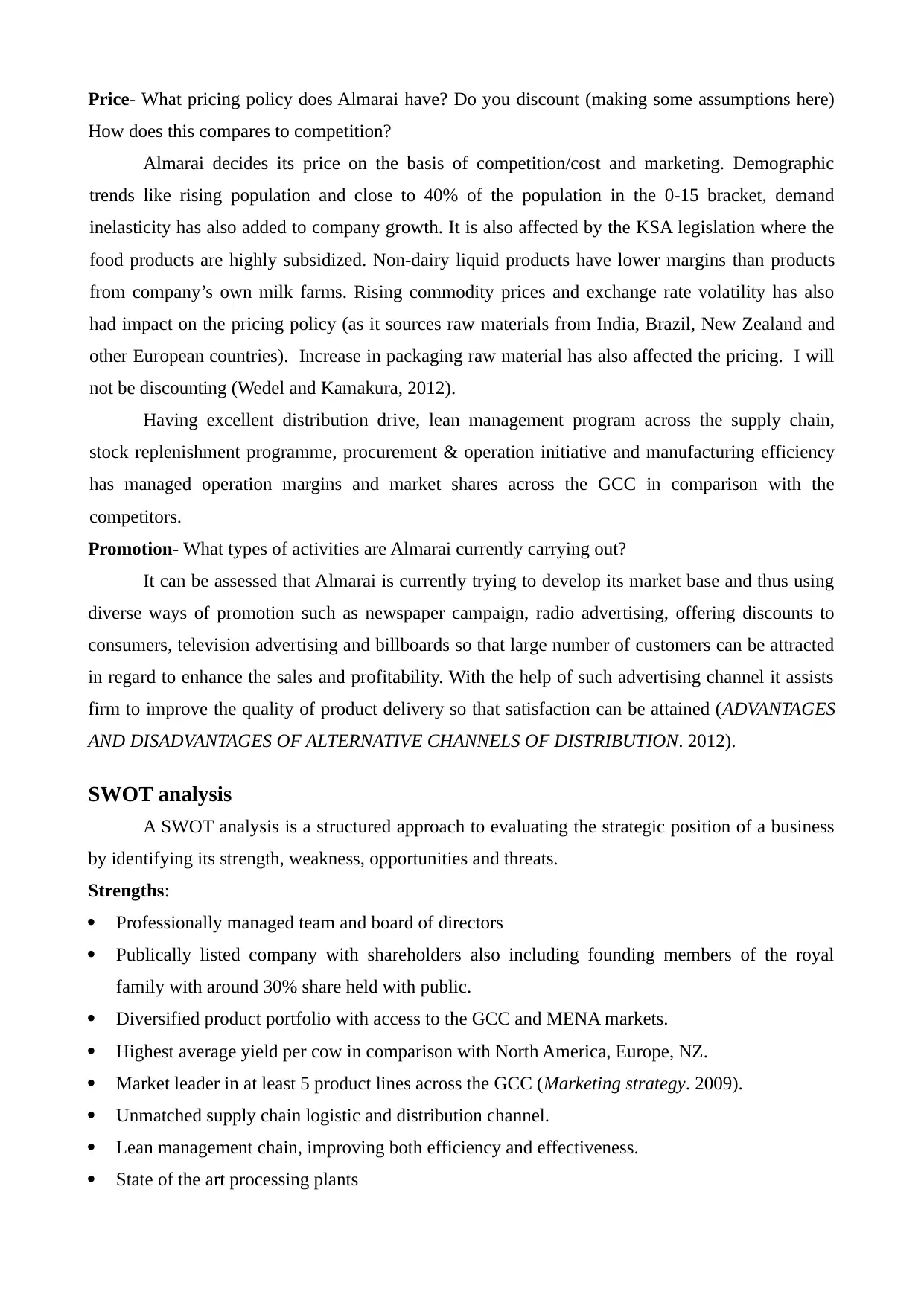
Price- What pricing policy does Almarai have? Do you discount (making some assumptions here)
How does this compares to competition?
Almarai decides its price on the basis of competition/cost and marketing. Demographic
trends like rising population and close to 40% of the population in the 0-15 bracket, demand
inelasticity has also added to company growth. It is also affected by the KSA legislation where the
food products are highly subsidized. Non-dairy liquid products have lower margins than products
from company’s own milk farms. Rising commodity prices and exchange rate volatility has also
had impact on the pricing policy (as it sources raw materials from India, Brazil, New Zealand and
other European countries). Increase in packaging raw material has also affected the pricing. I will
not be discounting (Wedel and Kamakura, 2012).
Having excellent distribution drive, lean management program across the supply chain,
stock replenishment programme, procurement & operation initiative and manufacturing efficiency
has managed operation margins and market shares across the GCC in comparison with the
competitors.
Promotion- What types of activities are Almarai currently carrying out?
It can be assessed that Almarai is currently trying to develop its market base and thus using
diverse ways of promotion such as newspaper campaign, radio advertising, offering discounts to
consumers, television advertising and billboards so that large number of customers can be attracted
in regard to enhance the sales and profitability. With the help of such advertising channel it assists
firm to improve the quality of product delivery so that satisfaction can be attained (ADVANTAGES
AND DISADVANTAGES OF ALTERNATIVE CHANNELS OF DISTRIBUTION. 2012).
SWOT analysis
A SWOT analysis is a structured approach to evaluating the strategic position of a business
by identifying its strength, weakness, opportunities and threats.
Strengths:
Professionally managed team and board of directors
Publically listed company with shareholders also including founding members of the royal
family with around 30% share held with public.
Diversified product portfolio with access to the GCC and MENA markets.
Highest average yield per cow in comparison with North America, Europe, NZ.
Market leader in at least 5 product lines across the GCC (Marketing strategy. 2009).
Unmatched supply chain logistic and distribution channel.
Lean management chain, improving both efficiency and effectiveness.
State of the art processing plants
How does this compares to competition?
Almarai decides its price on the basis of competition/cost and marketing. Demographic
trends like rising population and close to 40% of the population in the 0-15 bracket, demand
inelasticity has also added to company growth. It is also affected by the KSA legislation where the
food products are highly subsidized. Non-dairy liquid products have lower margins than products
from company’s own milk farms. Rising commodity prices and exchange rate volatility has also
had impact on the pricing policy (as it sources raw materials from India, Brazil, New Zealand and
other European countries). Increase in packaging raw material has also affected the pricing. I will
not be discounting (Wedel and Kamakura, 2012).
Having excellent distribution drive, lean management program across the supply chain,
stock replenishment programme, procurement & operation initiative and manufacturing efficiency
has managed operation margins and market shares across the GCC in comparison with the
competitors.
Promotion- What types of activities are Almarai currently carrying out?
It can be assessed that Almarai is currently trying to develop its market base and thus using
diverse ways of promotion such as newspaper campaign, radio advertising, offering discounts to
consumers, television advertising and billboards so that large number of customers can be attracted
in regard to enhance the sales and profitability. With the help of such advertising channel it assists
firm to improve the quality of product delivery so that satisfaction can be attained (ADVANTAGES
AND DISADVANTAGES OF ALTERNATIVE CHANNELS OF DISTRIBUTION. 2012).
SWOT analysis
A SWOT analysis is a structured approach to evaluating the strategic position of a business
by identifying its strength, weakness, opportunities and threats.
Strengths:
Professionally managed team and board of directors
Publically listed company with shareholders also including founding members of the royal
family with around 30% share held with public.
Diversified product portfolio with access to the GCC and MENA markets.
Highest average yield per cow in comparison with North America, Europe, NZ.
Market leader in at least 5 product lines across the GCC (Marketing strategy. 2009).
Unmatched supply chain logistic and distribution channel.
Lean management chain, improving both efficiency and effectiveness.
State of the art processing plants
Paraphrase This Document
Need a fresh take? Get an instant paraphrase of this document with our AI Paraphraser
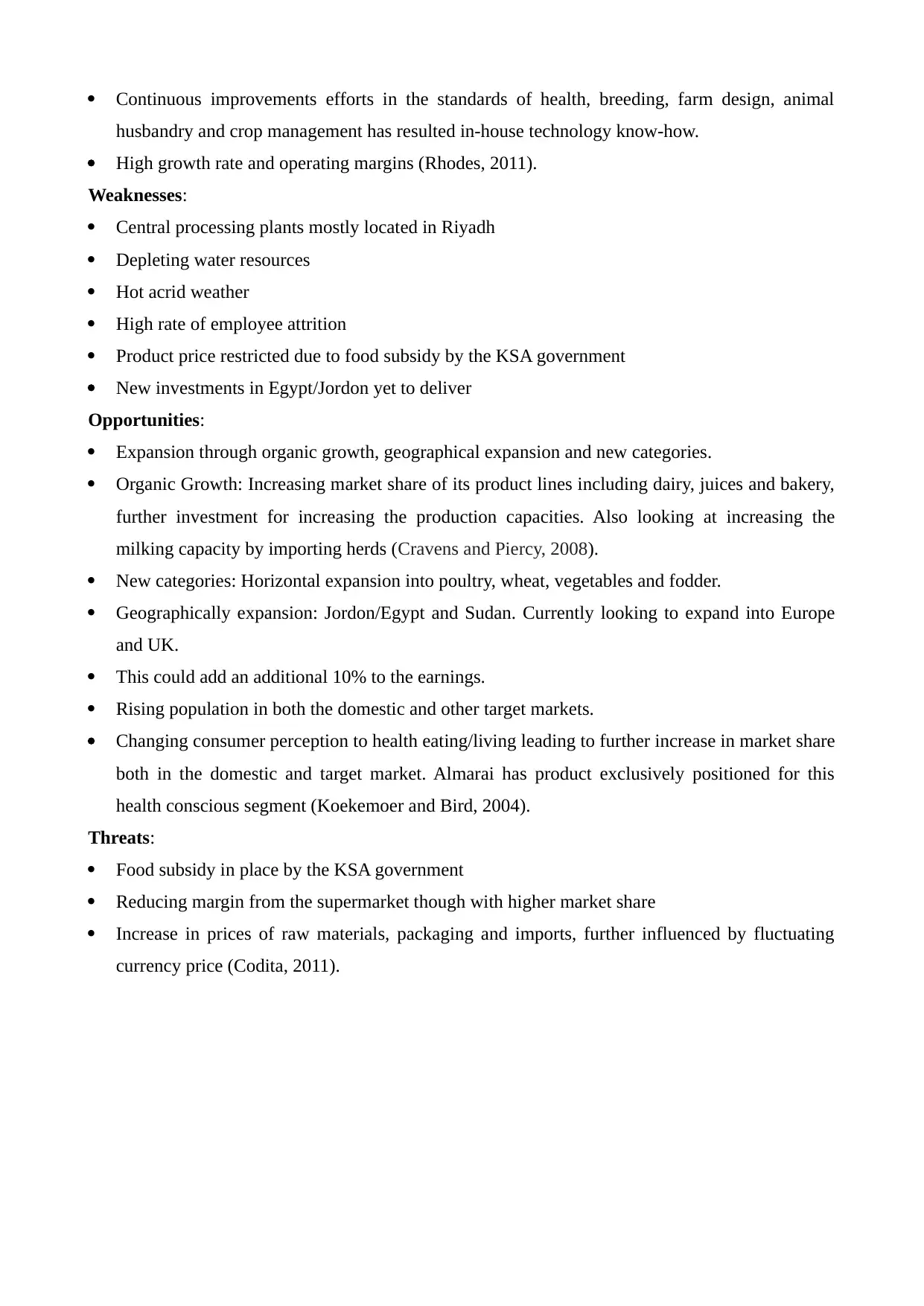
Continuous improvements efforts in the standards of health, breeding, farm design, animal
husbandry and crop management has resulted in-house technology know-how.
High growth rate and operating margins (Rhodes, 2011).
Weaknesses:
Central processing plants mostly located in Riyadh
Depleting water resources
Hot acrid weather
High rate of employee attrition
Product price restricted due to food subsidy by the KSA government
New investments in Egypt/Jordon yet to deliver
Opportunities:
Expansion through organic growth, geographical expansion and new categories.
Organic Growth: Increasing market share of its product lines including dairy, juices and bakery,
further investment for increasing the production capacities. Also looking at increasing the
milking capacity by importing herds (Cravens and Piercy, 2008).
New categories: Horizontal expansion into poultry, wheat, vegetables and fodder.
Geographically expansion: Jordon/Egypt and Sudan. Currently looking to expand into Europe
and UK.
This could add an additional 10% to the earnings.
Rising population in both the domestic and other target markets.
Changing consumer perception to health eating/living leading to further increase in market share
both in the domestic and target market. Almarai has product exclusively positioned for this
health conscious segment (Koekemoer and Bird, 2004).
Threats:
Food subsidy in place by the KSA government
Reducing margin from the supermarket though with higher market share
Increase in prices of raw materials, packaging and imports, further influenced by fluctuating
currency price (Codita, 2011).
husbandry and crop management has resulted in-house technology know-how.
High growth rate and operating margins (Rhodes, 2011).
Weaknesses:
Central processing plants mostly located in Riyadh
Depleting water resources
Hot acrid weather
High rate of employee attrition
Product price restricted due to food subsidy by the KSA government
New investments in Egypt/Jordon yet to deliver
Opportunities:
Expansion through organic growth, geographical expansion and new categories.
Organic Growth: Increasing market share of its product lines including dairy, juices and bakery,
further investment for increasing the production capacities. Also looking at increasing the
milking capacity by importing herds (Cravens and Piercy, 2008).
New categories: Horizontal expansion into poultry, wheat, vegetables and fodder.
Geographically expansion: Jordon/Egypt and Sudan. Currently looking to expand into Europe
and UK.
This could add an additional 10% to the earnings.
Rising population in both the domestic and other target markets.
Changing consumer perception to health eating/living leading to further increase in market share
both in the domestic and target market. Almarai has product exclusively positioned for this
health conscious segment (Koekemoer and Bird, 2004).
Threats:
Food subsidy in place by the KSA government
Reducing margin from the supermarket though with higher market share
Increase in prices of raw materials, packaging and imports, further influenced by fluctuating
currency price (Codita, 2011).
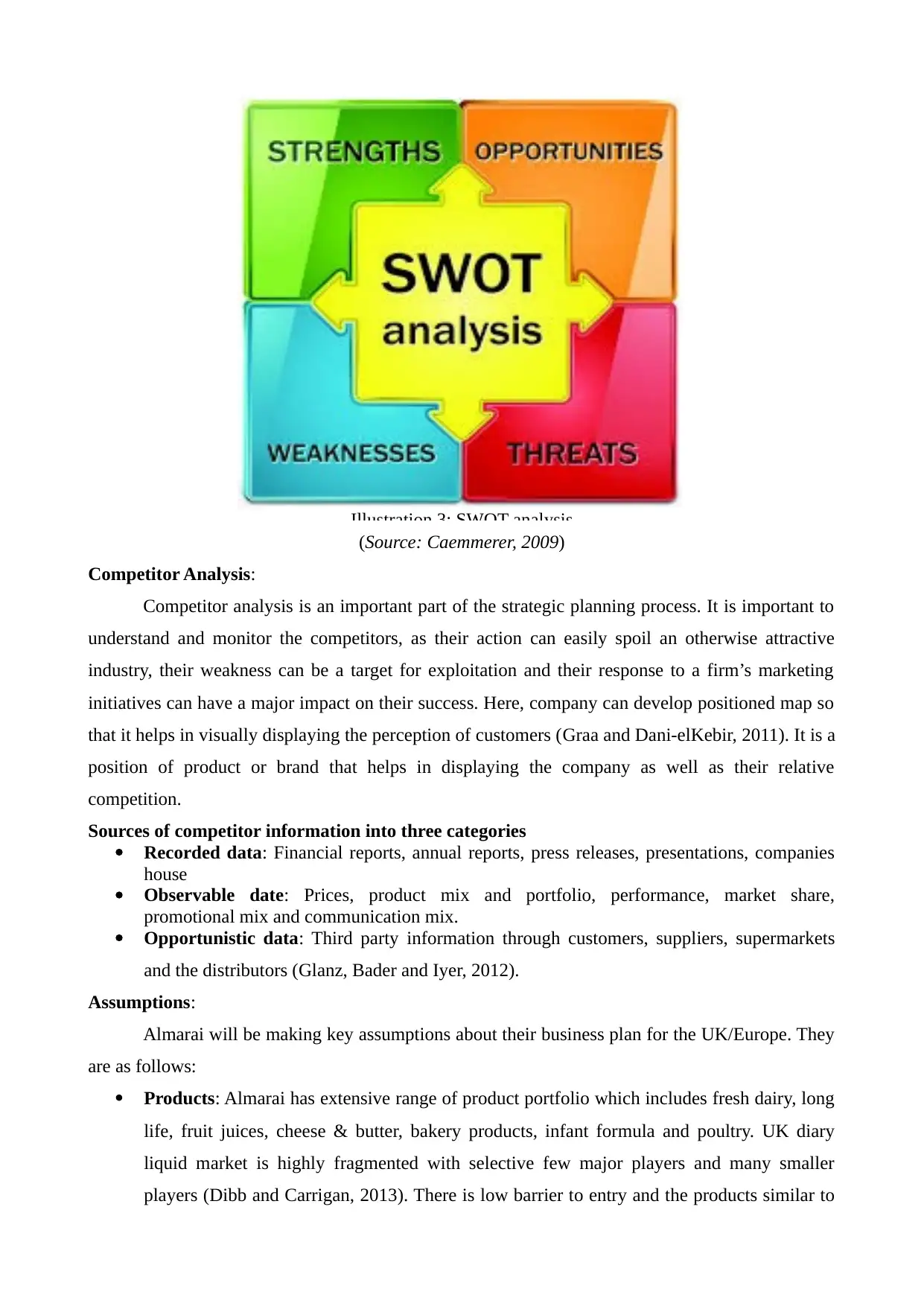
Illustration 3: SWOT analysis
(Source: Caemmerer, 2009)
Competitor Analysis:
Competitor analysis is an important part of the strategic planning process. It is important to
understand and monitor the competitors, as their action can easily spoil an otherwise attractive
industry, their weakness can be a target for exploitation and their response to a firm’s marketing
initiatives can have a major impact on their success. Here, company can develop positioned map so
that it helps in visually displaying the perception of customers (Graa and Dani-elKebir, 2011). It is a
position of product or brand that helps in displaying the company as well as their relative
competition.
Sources of competitor information into three categories
Recorded data: Financial reports, annual reports, press releases, presentations, companies
house
Observable date: Prices, product mix and portfolio, performance, market share,
promotional mix and communication mix.
Opportunistic data: Third party information through customers, suppliers, supermarkets
and the distributors (Glanz, Bader and Iyer, 2012).
Assumptions:
Almarai will be making key assumptions about their business plan for the UK/Europe. They
are as follows:
Products: Almarai has extensive range of product portfolio which includes fresh dairy, long
life, fruit juices, cheese & butter, bakery products, infant formula and poultry. UK diary
liquid market is highly fragmented with selective few major players and many smaller
players (Dibb and Carrigan, 2013). There is low barrier to entry and the products similar to
(Source: Caemmerer, 2009)
Competitor Analysis:
Competitor analysis is an important part of the strategic planning process. It is important to
understand and monitor the competitors, as their action can easily spoil an otherwise attractive
industry, their weakness can be a target for exploitation and their response to a firm’s marketing
initiatives can have a major impact on their success. Here, company can develop positioned map so
that it helps in visually displaying the perception of customers (Graa and Dani-elKebir, 2011). It is a
position of product or brand that helps in displaying the company as well as their relative
competition.
Sources of competitor information into three categories
Recorded data: Financial reports, annual reports, press releases, presentations, companies
house
Observable date: Prices, product mix and portfolio, performance, market share,
promotional mix and communication mix.
Opportunistic data: Third party information through customers, suppliers, supermarkets
and the distributors (Glanz, Bader and Iyer, 2012).
Assumptions:
Almarai will be making key assumptions about their business plan for the UK/Europe. They
are as follows:
Products: Almarai has extensive range of product portfolio which includes fresh dairy, long
life, fruit juices, cheese & butter, bakery products, infant formula and poultry. UK diary
liquid market is highly fragmented with selective few major players and many smaller
players (Dibb and Carrigan, 2013). There is low barrier to entry and the products similar to
⊘ This is a preview!⊘
Do you want full access?
Subscribe today to unlock all pages.

Trusted by 1+ million students worldwide
1 out of 19
Related Documents
Your All-in-One AI-Powered Toolkit for Academic Success.
+13062052269
info@desklib.com
Available 24*7 on WhatsApp / Email
![[object Object]](/_next/static/media/star-bottom.7253800d.svg)
Unlock your academic potential
Copyright © 2020–2025 A2Z Services. All Rights Reserved. Developed and managed by ZUCOL.




